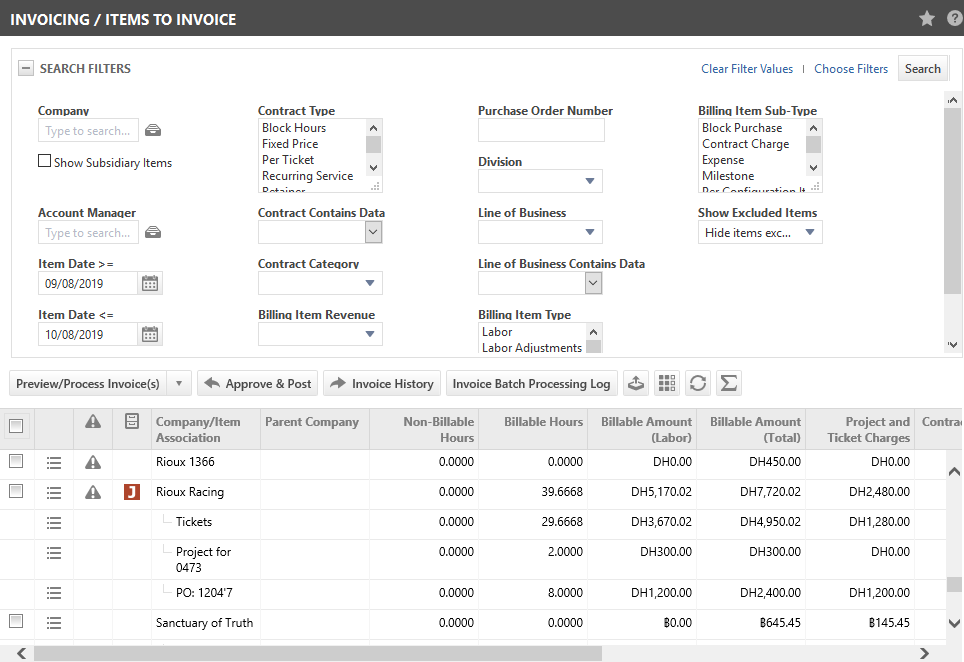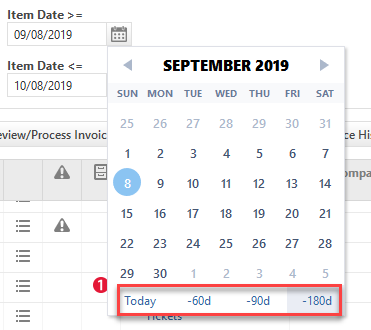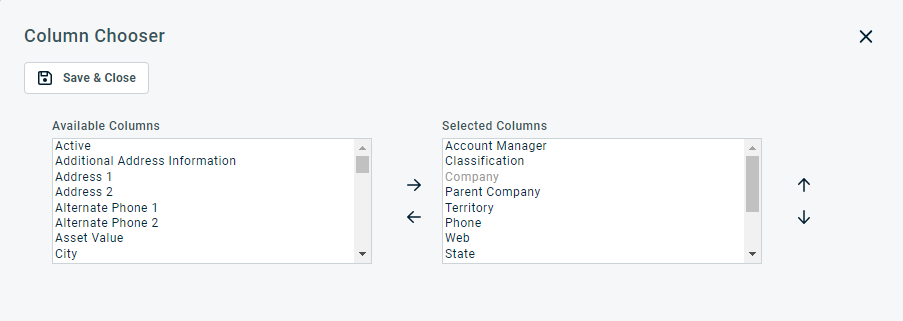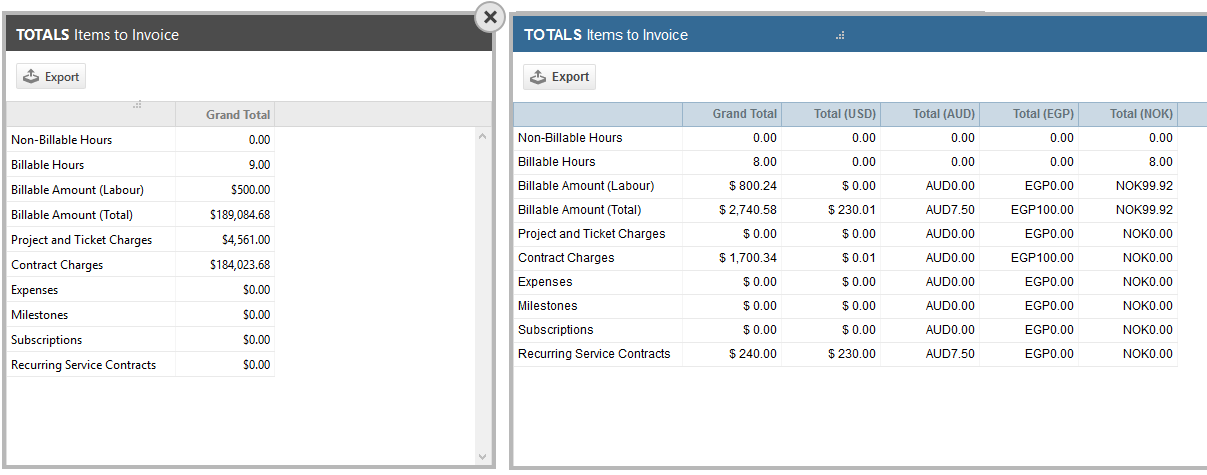Selecting items to invoice
PERMISSIONS Manager or security level with Contract Visibility set to All
NAVIGATION Left Navigation Menu > Contracts > Invoices & Adjustments > Invoicing / Items to Invoice
On the Invoicing / Items to Invoice page, you filter the transactions you want to invoice and initiate the processing of invoices. To open the page, use the path(s) in the Security and navigation section above.
How to...
- To display a list of all records of a given entity in your Autotask instance, click Search without applying any filters.
Search results containing more than 25, 50, or 100 records (depending on your Records per page setting) are paginated. Use page navigation to view additional results. At most, 5,000 data record will be retrieved at any one time.
- To search for specific records, apply one or more search filters. Refer to Applying a search filter.
The Active filter defaults to Active on the Organization Search, Contact Search, My Organizations, and My Contacts pages, as well as on the global Search by Organization, Contact (First Name), Contact (Last Name), and Contact (Email). The counters in the My menu also reflect only active entities.
NOTE There are several options for phone number filters. The Phone filter will look for a contains match that includes any characters (such as - or () ) entered in the filter box. The Organization Search and Contact Search pages have a Phone (numbers only) option that will ignore special characters in the filter and the results. It will do a contains search for just the numbers entered in the filter box. The Contact Search page also allows you to do a Phone (Starts With) search. It will search for phone numbers that start with the value entered in the filter box.
| Filter Name | Description |
|---|---|
| Billing Item Revenue |
This filter determines whether billing items that are set as non-billable OR whose revenue value is 0.00 will be included in the search results. Click the drop-down menu and select one of the options:
Including non-billable and zero revenue items lets you show the work you did for the customer. Time entries that fall under a prepaid contract will appear on the invoice with Prepaid (for block and retainer purchases) or Covered by Per Ticket (per ticket purchases). All fixed price and recurring service time entries will show as Covered by Contract. |
| Billing Item Sub-Type |
This filter is more granular than the Billing Item Type filter. Filter by:
|
| Billing Item Type |
Contains the following options:
|
| Contract Contains Data |
Filters on whether each billing item has an associated contract.
|
| Customer Currency (only displayed if Multi-currency is enabled) |
If Multi-currency is enabled, the Invoicing / Items to Invoice table displays all amounts in each organization's customer currency. Subtotals are shown for each currency, and a grand total is shown in the internal currency. You can filter by currency. The drop-down menu contains all active currencies, and any inactive currencies that are associated with an organization that has items to invoice. |
| Division | This filter is available if Organizational Structure is enabled. When a division is selected, the search results will only return billing items associated with a line of business in that division. |
| Item Association |
This filter has replaced and expanded the Project Items filter.
|
| Item Dates |
The Item Date is the date worked for labor items and the transaction dates for other types of billable items, including labor adjustments. The default date range is greater than or equal to the current day minus 30 days. You can extend the date range to a maximum of 2 years. NOTE If you apply an Organization filter, the date range limit is extended to two years prior to the current date and ten years after the current date. Any labor adjustments made during the specified date range will be included in the search result. The original billing item for those adjustments will also be included if the item has not yet been invoiced. Note that the date of the original billing item may fall outside of the specified date range. If you click the calendar item next to the Item Date filters, you can apply date shortcuts. The same shortcuts are available on the Posted Date filters. |
|
Line of Business |
This filter is available if Organizational Structure is enabled. When a line of business is selected, the search results will only return billing items associated with the selected pairing. NOTE In the results table, the line of business will be displayed for Projects rows only. |
| Purchase Order Number |
Enter a purchase order number to return all approved and posted items assigned to the purchase order. This is a "contains" search. If an organization has billable items with purchase orders assigned, a separate invoice is generated for each purchase order number. |
|
Show Sub-Organization Items
|
Select this check box if you want the search results to include billing items for the selected organization's sub-organizations that are explicitly configured not to bill to the parent organization. These items will not be automatically included on the invoice, but they will be available for inclusion on the Choose Billing Items dialog box. IMPORTANT For items to be available on the Choose Billing Items dialog box, they must be returned by the search in the first place. You must check Show Sub-Organization Items and Show Excluded Items on the Invoice / Items to Invoice search to later have the option to include them on Choose Billing Items. Items that fall under a parent or sub-organization contract will be governed by that contract. This check box does not control items billable to the sub-organizations showing in the table below. To locate items and generate invoices for items billable to the sub-organizations, you must filter by or select those organizations individually. For more information on parent organization/sub-organization invoicing, refer to Invoicing sub-organization items to a parent organization. |
| Show Excluded Items | This filter controls if billing items excluded by the default invoice template for each organization will appear in the search results. IMPORTANT For items to be available on the Choose Billing Items dialog box, they must be returned by the search in the first place. You must check Show Sub-Organization Items and Show Excluded Items on the Invoice / Items to Invoice search to later have the option to include them on Choose Billing Items.
|
| User-Defined Fields | Organization, Contract, and Subscription User-Defined Fields are available as filters on the page. |
The following tool buttons appear above the results list:
| Tool Button | Description |
|---|---|

|
Click to preview and process selected invoices. Refer to Processing invoices. At least one organization must be selected. |

|
Click to navigate to the Approve & Post page. |

|
Click to navigate to the Invoice History page. Refer to Managing invoices from Invoice History. |

|
Click to open the Invoice Batch Processing Log page. Refer to Invoice Batch Processing Log. This button is visible to all users whose security level has Can Invoice set to anything besides None OR has Can access Invoice History and (Invoice) Export Wizard set to TRUE. |
|
PERMISSIONS By default, Export is available to users with Admin security level and disabled for all others. It can be enabled for other security levels. Refer to Can export Grid Data. NOTE When exporting to CSV: To ensure consistent date/time formatting in the CSV output, we strongly recommend that the user’s date/time format settings in Autotask be identical to the Windows date/time format settings of the computer performing the export. This will prevent conflicts in how the software that generates the report interprets the date/time format.
NOTE Note that only the selected columns of the first 5,000 records will be exported. IMPORTANT The export file does not contain all fields that are required to re-import the data using the data import templates, and the data headers do not match. |
|
|
|
The Column Chooser allows you to customize search results tables throughout Autotask. It determines the following:
NOTE Column Chooser settings on search results tables and some standard reports are part of the user settings stored on the Autotask server. You can log in from any computer and have your column chooser settings applied to your Autotask session. To clear the data stored in your Autotask instance and reset the column chooser settings to the Autotask default settings, click Reset Settings in My > Miscellaneous > Settings. To customize the table, do the following:
Columns appear either in the Available Columns or the Selected Columns panel.
NOTE Top-to-bottom order in the Selected Columns list becomes left-to-right order on the Search Results list.
TIP If the characters + # appear after the column name, then that column may have multiple items returned for some rows. If that occurs, the first item will appear in the row followed by + and the number of additional items returned. To display the list of additional items, hover over the item in the column. |
|
Click the refresh icon |
|
|
The Totals dialog box displays the Grand Total for all columns you have selected on the table column chooser. If you use a single currency, it simply lists the grand totals for all columns you have selected on the table column chooser. This list can be exported to .CSV. If Multi-currency is enabled, additional columns appear on the table (one for each additional currency). Each will represent a per-currency total of all returned billing items for the organizations that have each currency. Currency values in the Grand Total column are calculated from the billing items' internal currency values and are displayed in the internal currency. |
There are two basic types of rows on the Invoicing / Items to Invoice page table:
- Organization rows: Organization rows represent the organizations for which there are billing items available to invoice that meet your filter criteria.
- Billing item grouping rows: Grouping rows exist in three sub-varieties. These are Tickets, Project, and Purchase Order. They represent more granular subsets of billing items that belong to each of those organizations.
Grouping rows only exist alongside organization rows, while organization rows may exist without any grouping rows. Billing Items are grouped as follows:
| Row Type | Description |
|---|---|
| Organization row |
Each organization row contains a check box that allows it to be selected for processing. You can also click the organization name to launch the Process Selected Invoices dialog box. All available billing items for the selected organization, its sub-organizations (if configured to bill to their parent organization), or the organizations that have it set as their "bill to" organization are available for invoicing. |
| Ticket(s) grouping row |
The Tickets grouping row (there is only ever one per organization row) includes all billing items (labor, charges, expenses) that are associated with tickets for the organization in the row above it, as long as those billing items do not have purchase order numbers. To launch the Process Selected Invoices dialog box for items in this grouping, click the Tickets label. |
| Project grouping row |
Each Project grouping row represents billing items associated with one specific project and is labeled with that project's name. If the project has a purchase order number, it is listed in parentheses after the project name, and only billing items with the same purchase order number will be included in that row. Billing items whose purchase order numbers differ from their project's purchase order number are not included in these rows. They are listed under the separate purchase order number. If a project has billing items that do not have purchase order numbers, a project grouping row will appear for that project, followed by the project (PO: ) grouping row. To launch the Process Selected Invoices dialog box for items in this grouping, click the Project label. |
| Purchase Order grouping row |
Purchase Order grouping rows represent billing items that are associated with purchase orders. These rows appear on the table when there are items that are associated with tickets and have a purchase order number, or items that are associated with projects and have a purchase order number that differs from the project's PO number. Each Purchase Order grouping row represents one specific purchase order. Purchase order always wins. Columns for purchase order grouping rows show data aggregated from all billing items that have the given purchase order number, excluding only billing items that are both associated with projects AND have the same purchase order number as their project. To launch the Process Selected Invoices dialog box for items in this grouping, click the PO label. |
Each billing item grouping row will result in a separate invoice, even if you click the organization row.
Context menus are available in both Organization and Tickets and Project and P.O. grouping rows.
| Item | Description |
|---|---|
| Organization Rows | |
| Preview/Process Invoice(s) > All for Organization | Click to open the Process Selected Invoices dialog box for the selected organization. All billing items are included. |
| View/Edit > View Organization | Click to open the Organization page. |
|
View/Edit > Edit Invoice Settings |
Click to open the Invoice Settings page for the selected organization. |
| Tickets, Project and P.O. grouping rows | |
| Preview/Process Invoice |
Click to open the Process Selected Invoices dialog box for the selected Tickets, Project or P.O. grouping row. This is the equivalent of clicking on the grouping hyperlink. |
- To process all invoices in the Invoicing table, check the check box in the header row of the table or use the Preview/Process Invoice(s) drop-down menu and select Preview/Process for all Organizations.
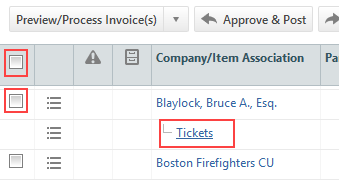
To process invoices for specific organizations, select the check box on their organization rows and select Preview/Process for Selected Organizations from the drop-down menu, or click the organization name.
To process the invoice for a specific Tickets, Project or PO grouping, click the grouping label.
NOTE When you select individual rows, you are limited to 175 organizations. If you select the check box in the header row, and do not select or clear any additional check boxes, there is no limit on the number of organizations.
- The Process Selected Invoices dialog box will open. Refer to Processing invoices.
